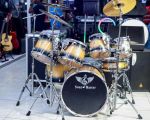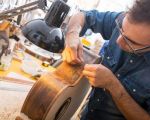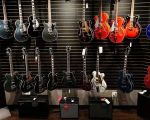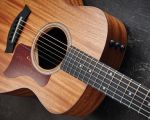
- Why Choosing the Right Acoustic Guitar for Intermediate Players Matters
- Key Features to Consider When Selecting Intermediate Acoustic Guitars
- In-Depth Reviews of Top Acoustic Guitars for Intermediate Players
- Personal Experience and Real-World Case Studies
- Where to Find the Best Deals and Recommendations
1. Why Choosing the Right Acoustic Guitar for Intermediate Players Matters
For many guitarists, moving beyond the beginner stage marks a crucial turning point in their musical journey. At this intermediate level, selecting the right acoustic guitar is not just about upgrading your instrument; it’s about finding a guitar that complements your evolving skills, inspires creativity, and supports your long-term development. Choosing poorly can lead to frustration, stagnation, or even abandoning the instrument altogether.
Intermediate players need guitars that balance quality craftsmanship and affordability. Unlike entry-level models, these guitars offer better tonewoods, improved hardware, and more nuanced playability. In fact, this is where you start to notice the difference in sound clarity, sustain, and overall feel, making the selection process essential for your progression.
Understanding what to look for in an acoustic guitar at this stage can be overwhelming, especially with the vast options available on the market. That’s why we focus here on the best acoustic guitars for intermediate players, providing detailed insights that help you make an informed decision.
2. Key Features to Consider When Selecting Intermediate Acoustic Guitars
2.1 Tonewoods and Their Impact on Sound Quality
The choice of tonewoods significantly affects the guitar’s sound character. Spruce tops are popular for their bright, clear tone and responsiveness, making them an excellent choice for versatile playing styles. Mahogany tops, on the other hand, offer a warmer, more mellow sound suited for blues and folk genres.
Back and side woods like rosewood and mahogany add depth and richness to the guitar’s voice. For intermediate players, investing in a guitar with solid wood (rather than laminate) tops can dramatically improve sound quality and resonance over time.
2.2 Body Shape and Size
The guitar body shape influences tone and comfort. Dreadnoughts produce a powerful, bass-heavy sound, perfect for strumming and band settings. Concert and auditorium shapes provide a balanced tone with more emphasis on midrange frequencies, ideal for fingerstyle playing and solo performances. Understanding your playing style will guide you to the best fit.
2.3 Playability and Neck Profile
At the intermediate stage, comfort is paramount. Neck width, profile, and fretboard radius affect how easily you can form chords and execute complex fingerings. A slimmer neck with smooth fret edges can enhance your playing speed and reduce fatigue during longer practice sessions.
2.4 Electronics and Additional Features
If you plan to perform live or record, built-in pickups and preamps are valuable features to consider. Many intermediate guitars come with quality electronics that capture the natural acoustic tone while offering flexibility in sound shaping through EQ controls.
3. In-Depth Reviews of Top Acoustic Guitars for Intermediate Players
3.1 Yamaha FG830
The Yamaha FG830 is often hailed as a breakthrough guitar for intermediate players due to its remarkable balance of affordability and professional-grade tone. Featuring a solid spruce top with rosewood back and sides, it delivers rich, vibrant sound with excellent projection. Its neck profile supports comfortable playability across styles. Many users have praised its durability and versatility, making it a staple recommendation in numerous guitar forums and reviews.
3.2 Taylor 214ce
Taylor’s 214ce model is another favorite, particularly for players looking for premium sound with a smooth finish. Its layered rosewood back and sides combined with a solid spruce top offer a bright yet warm tonal palette. The guitar’s ergonomic Grand Auditorium shape ensures comfort during extended playing sessions. Its onboard Expression System 2 electronics provide clear amplified sound, making it ideal for both practice and performance.
3.3 Fender CD-60SCE
Fender’s CD-60SCE bridges affordability and quality, tailored for players wanting an acoustic-electric guitar with rich tone. Solid spruce top and mahogany back and sides give it a full-bodied sound. Its cutaway design allows easy access to higher frets, perfect for lead playing and solos. Many players appreciate the guitar’s easy setup and reliability as their skills advance.
4. Personal Experience and Real-World Case Studies
One of our readers, Emma, shared her journey upgrading from a beginner guitar to a Yamaha FG830. She described how the upgrade reignited her passion for guitar, especially as the improved tone motivated her to practice more frequently. Emma noted that the guitar’s balanced sound made it easier to experiment with fingerpicking styles, something she struggled with on her previous instrument.
Another case involves Mark, an intermediate player who chose the Taylor 214ce after months of research. Mark performs regularly in small venues and found that the guitar’s onboard electronics greatly enhanced his live sound, giving him confidence on stage. He emphasizes the importance of a guitar that supports both acoustic purity and amplified flexibility for players who perform.
These real-life stories underline how selecting the right guitar can transform your playing experience and inspire progress.
5. Where to Find the Best Deals and Recommendations
Finding the best acoustic guitar for intermediate players can be daunting, but resources like Beat Trigger can simplify your search. They offer curated selections tailored to your skill level and style preferences, helping you avoid common pitfalls and ensuring you invest in a guitar that fits your needs. Beat Trigger also provides access to trusted sellers and services, which can be invaluable for maintenance, upgrades, or personalized advice.
Additionally, checking out user reviews and hands-on demos, when possible, will deepen your understanding of what each guitar offers. Visiting music stores, trying different models, and asking for expert opinions remain key steps in the process.








